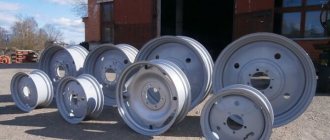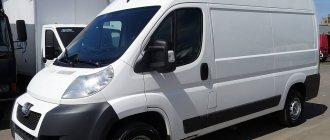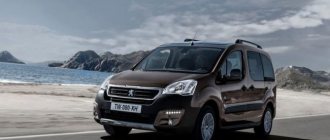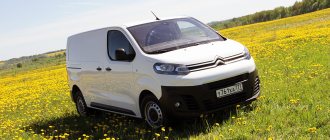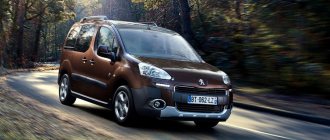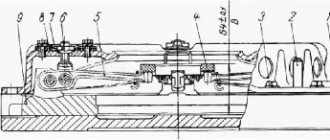Peugeot Boxer is an economical, reliable and multifunctional commercial vehicle that meets Euro 4 environmental standards. The chassis of the model is created taking into account European requirements for efficiency and safety and allows for the most complex work. The Peugeot Boxer family is represented by a huge number of modifications with different wheelbases, power plants, lengths and body options. Thanks to this, any client can find exactly the option that suits him best.
All versions of the Peugeot Boxer are category “B”, so they can be driven by a driver with the appropriate category, which is very convenient. Peugeot Boxer is distinguished by:
- better load capacity;
- optimal ratio of quality and price;
- minimum cost of maintenance;
- the most spacious body in the segment.
Model history and purpose
The production of models of the Peugeot Boxer family began in 1994 at the Italian SEVEL plant. Features of the first generation of the model include a base on a frame, a front transverse engine, and an independent wishbone-spring front suspension. All versions of the debut Peugeot Boxer were equipped exclusively with a 5-speed manual transmission. The creation of the model was carried out by a joint group of specialists from PSA Peugeot Citroen and Fiat. The result of their activities was 3 cars, differing little in design and construction: Citroen Jumper, Fiat Ducato and Peugeot Boxer.
The Peugeot Boxer I was offered in 4 main versions: chassis, minibus, van and light truck. The line of power units consisted of a 2-liter gasoline engine (110 hp) and 5 diesel engines of 1.9-2.8 liter capacity (68-128 hp). The wheelbase of the first generation varied between 2850-3700 mm, length - 4749-5599 mm.
In 2002, the French carried out a serious facelift of the model. It affected the radiator grille and both bumpers. The interior of the Peugeot Boxer has also changed noticeably. The car was also equipped with plastic body moldings and enlarged headlights with shades without a pattern. The rear of the facelift version featured a rounded bumper, a new nameplate and lights with holes for ventilation. In the engine range, 2.3- and 2.8-liter units replaced 1.9-liter diesel engines. However, most of the elements remained the same (doors, external panels).
Another 4 years later, the second generation of the model premiered. This option is still relevant today. The second Peugeot Boxer was the result of the work of French and Italian specialists who tried to significantly improve all the details of the product and introduce novelty into design solutions that had remained unchanged for many years. The interior design, security systems, design and engine range were redesigned. The number of available modifications has also increased (about 50).
The exterior of the new Peugeot Boxer was designed by Italian designers from the Fiat Centro Style department. They decided to move away from the cubic car design common at that time. As a result, a massive bumper with a U-shaped radiator grille was developed. There was a miniature hood cover above its lip, and the headlights had a complex shape. Due to the low glazing line and the huge windshield, excellent visibility was provided. On the side, vertical mirrors and voluminous wheel arches stood out. The passenger versions, in addition to hinged doors at the front, had a sliding door on the right side. The cabin of the model was made 3-seater. In addition to the standard dials (tachometer, speedometer, temperature sensor), an on-board computer appeared on the panel. It itself was made of soft plastic. A variety of storage spaces and accessories have appeared at the workplace: a glove box, a pull-out table, a niche for papers, a cup holder.
In 2014, the Peugeot Boxer was updated again. The technical characteristics of the model remained the same, and the changes affected only the appearance.
Peugeot Boxer II is offered in several versions that determine the capabilities of the model:
- An all-metal van (Peugeot Boxer Ft) is used for transporting various goods and as a technical assistance vehicle, a furniture van, a special vehicle (Ministry of Internal Affairs, Ambulance, Ministry of Emergency Situations), an isothermal van and a mobile radio or television studio.
- The cargo-passenger variation (Peugeot Boxer Combi) is used for transporting passengers and delivering goods. The car is equipped with 9 passenger seats in the cabin with various options for their location. The seats are of high quality finishing (hard or soft). Quick-release fasteners have been developed specifically for this design.
- Minibus (Peugeot Boxer Tour Transformer) is a model with a variable interior configuration, guaranteeing an optimal level of comfort. Inside the car there are folding sofas that can be unfolded, folded and stowed away, transforming the car interior into a camper, van, combi or mobile office.
- The chassis with cab (Peugeot Boxer Chassis Cab) is the most versatile version of the car, providing the ability to install various add-ons on the frame and perform a wide variety of work. Due to the modular design and the same distance between mounting holes, conversion is carried out with minimal time and effort. The most popular versions of cars based on the Peugeot Boxer chassis are: isothermal van, flatbed, refrigerator, dump truck, crane, awning, manufactured goods van, tank and furniture van.
Currently, the Peugeot Boxer is considered one of the leaders in its segment. An unpretentious, economical and powerful car will be an excellent assistant in business and in the family. The domestic client is offered models assembled from imported kits at a plant in the village of Rosva (Kaluga region).
How discs are marked
Each disc has an individual marking indicating:
•disc diameter;
•its width;
•number of holes for mounting to the hub;
•diameter of a conventional circle passing through the axes of these holes;
•disc ejection.
Wheel rim bolt pattern compatibility table
Let's look at an example of full marking 9JX16 Н2 5/112 ET 35 D 66.6
9 – disk width (in inches);
J – designation indicating that the disk is intended for a one-wheel drive car (wheels for all-wheel drive vehicles are designated by two letters JJ);
X – disc manufacturing method (cast);
16 – installation diameter (in inches);
H2 – marking indicating the number of annular protrusions holding the tubeless tire (2);
5/112 – number of mounting holes/diameter of the circle on which they are located (bolt pattern);
ET 35 – disc offset value (in millimeters);
D 66.6 – diameter of the central (hub) hole of the disk.
Specifications
The second generation Peugeot Boxer is offered in various versions with 3 wheelbase options: 3000, 3450 and 4035 mm. All variations have the same width (2050 mm), but differ in length (4963 mm, 5413 mm, 5998 m, 6363 mm) and height (basic - 2254 mm, extended - 2764 mm). There are also several options available for internal height (1662 mm, 1932 mm, 2172 mm) and internal volume (8, 10, 11.5, 13, 15 and 17 cubic meters). The indices C, M, L and LL characterize the size of the wheelbase - from small to large. Additional indices S, H and HS determine the level of the roof.
The total weight of the model varies depending on the modification - 3000, 3300, 3500, 4000 kg. The load capacity depends on this parameter - 1090-1995 kg.
Fuel consumption
Average fuel consumption for the Peugeot Boxer II is 10.8 l/100 km (urban) and 8.4 l/100 km (extra-urban). At the same time, the fuel tank holds up to 90 liters.
Peugeot Boxer rim and wheel sizes
Wheel parameters for the model: 6 by 15 ET55 or 6 by 15 ET68 (5 holes) with tire sizes 205/75 R16 or 215/75 R16.
Features of vehicle bolt pattern parameters
It is worth noting that each model for a particular vehicle brand has its own characteristics:
- rim width;
- disk diameter;
- diameter circle;
- rim offset size;
- some other parameters.
To prevent premature tire wear and damage to the vehicle suspension. When choosing tires, it is imperative to pay attention to such an aspect as technical characteristics. If you encounter difficulties in selecting the most suitable tires, you can always seek advice from store employees who will help you choose tires, taking into account, first of all, the model of your car, the budget you plan to spend on the purchase, as well as some other parameters.
Engine
The second generation of the Peugeot Boxer is equipped with 2.2- and 3-liter diesel units of varying power. These engines are a joint development of PSA Peugeot Citroen and Ford Motor Company. They are based on diesel engines of the DW family from PEUGEOT, which are distinguished by their long service life and reliability. Among the features of the motors are:
- cylinder head made of light alloy AS7;
- Common Rail direct injection system (3rd generation);
- system for searching for soot particles in engine oil;
- timing drive with double-row roller chain;
- cylinder block made of high-strength cast iron.
The most popular in Russia are modifications with a 2.2-liter diesel engine with the following characteristics:
- rated power – 96 (130) kW (hp);
- torque – 320 Nm;
- number of cylinders – 4;
- cylinder diameter – 86 mm.
2.2-liter diesel versions with 100 hp are also quite common.
Photo
Device and repair
The body of the Peugeot Boxer is almost entirely made of steel sheets with a thickness of 1.8 mm. Thanks to this, it withstands road damage and impacts well compared to vans of a similar class. It is given additional strength by a chassis with increased rigidity. The design of the model is thought out to the smallest detail. The Peugeot Boxer is designed to minimize the accumulation of dirt and dust in hard-to-reach areas. Almost 70% of the metal used in the structure is galvanized steel. Its outer surfaces are galvanized twice and then covered with 5 layers of special protective material. This technology reliably protects the car from corrosion.
As standard, the model is equipped with electrically heated and electrically adjustable exterior mirrors. Moreover, each mirror has 2 glasses (one spherical), which reduces “dead spots” for the driver. The high seating position and large windows make driving very comfortable. The driver's seat has many adjustments (unlike the passenger seat).
The front suspension of the Peugeot Boxer is well tuned. In combination with power steering, it ensures precise maneuvering and ease of driving. The basic equipment also includes modern ABS. Additionally, you can install ASR, overtaking sensor, rear view camera, ultrasonic sensors and parking assistant.
Compared to domestic GAZelles, the Peugeot Boxer seems like a car from another planet. Everything here is fundamentally of higher quality, which is confirmed by many positive reviews from the owners. At the same time, the operation of the machine must be accompanied by adequate seasonal training, quality control of the fuel supplied and timely maintenance. Compared to its competitors, the Peugeot Boxer has a more comfortable and spacious interior with advanced equipment, a high-torque engine that allows it to accelerate quite quickly to high speeds even with a loaded cabin, and low fuel consumption.
However, the model also has disadvantages. They are associated with the adaptation of the Frenchman to Russian operating conditions. On domestic roads, the Peugeot Boxer does not always feel comfortable. It is also not recommended to service your vehicle at unauthorized service centers. Problems especially often arise with ball joints, electronics and steering ends. In winter, the car takes a long time to warm up, but the interior remains cold.
Caring for newly purchased wheels
During operation of the machine, the discs constantly become dirty. Naturally, they require care. Recipes for a variety of cleaning products circulate on car enthusiast forums, some very dubious. For example, the disk surface will never forgive these types of cleaning products:
- Oven sprays. Due to aggressive components, they destroy paint and even metal. They are also difficult to remove from the surface and damage the rubber.
- Acidic and alkaline agents. They remove dirt well, but provoke corrosion.
- Steel brushes and sandpaper. They spoil the paint, scratch, and disfigure the surface of the discs.
- Household cleaners. The paint is peeled off and the metal begins to corrode.
- Lighter fluid. By burning dirt, car owners damage their wheels.
- Toothpaste and brush. They clean well, but are too hard for the surface.
- High pressure washer. The hose should not be brought closer to the disc than 30 cm. Otherwise, the paint can be damaged.
Normal disc care involves the use of special acid-free cleaners. They are applied, left on for a while and washed off with a stream of water. There are also special means for protection against dirt and atmospheric factors.
Price of new and used Peugeot Boxer
The latest generation of Peugeot Boxer is offered on the Russian market at a price starting from 1.019 million rubles.
For this money you can purchase the basic modification L1H1 with a 2.2-liter diesel engine (130 hp) and the following equipment: airbag, EBA, ABS, central locking, spare wheel, immobilizer, steel wheels, halogen headlights, audio preparation, adjustment seats, electric front windows, adjustable steering column, power steering and on-board computer. The top-end version is considered to be the L4H3, costing 1.209 million rubles. Used versions of the Peugeot Boxer in Russia are offered at prices starting from 400,000 rubles (normal condition). Models from 2006-2008 with a mileage of about 300,000 km will cost 380,000-480,000 rubles, cars from 2009-2011 - 550,000-900,000 rubles.

